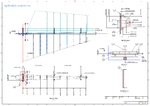Hugh_T
Airman
Continuing with my research on the construction of the F4F I have noticed that the leading edge of the Horizontal stabiliser drops by just under 0.5 degrees. Effectively an Anhedral and not a dihedral as one would expect.
The main spar is set back by 1 degree and is perpendicular to the vertical plane of the fuselage. It is the ribs that set the incidence angle of 1.5 degrees. Following the Grumman drawings, it transpires that in doing so the end result is that the leading edge tends to drop outboard by 0.5 degrees as shown below.
I don't believe this was the intent and it would certainly be unusual. Before I correct the alignment I need to just be sure that my thoughts on this are correct...it may well be that it is what was intended.
I would appreciate any comments.


The main spar is set back by 1 degree and is perpendicular to the vertical plane of the fuselage. It is the ribs that set the incidence angle of 1.5 degrees. Following the Grumman drawings, it transpires that in doing so the end result is that the leading edge tends to drop outboard by 0.5 degrees as shown below.
I don't believe this was the intent and it would certainly be unusual. Before I correct the alignment I need to just be sure that my thoughts on this are correct...it may well be that it is what was intended.
I would appreciate any comments.


Last edited:

